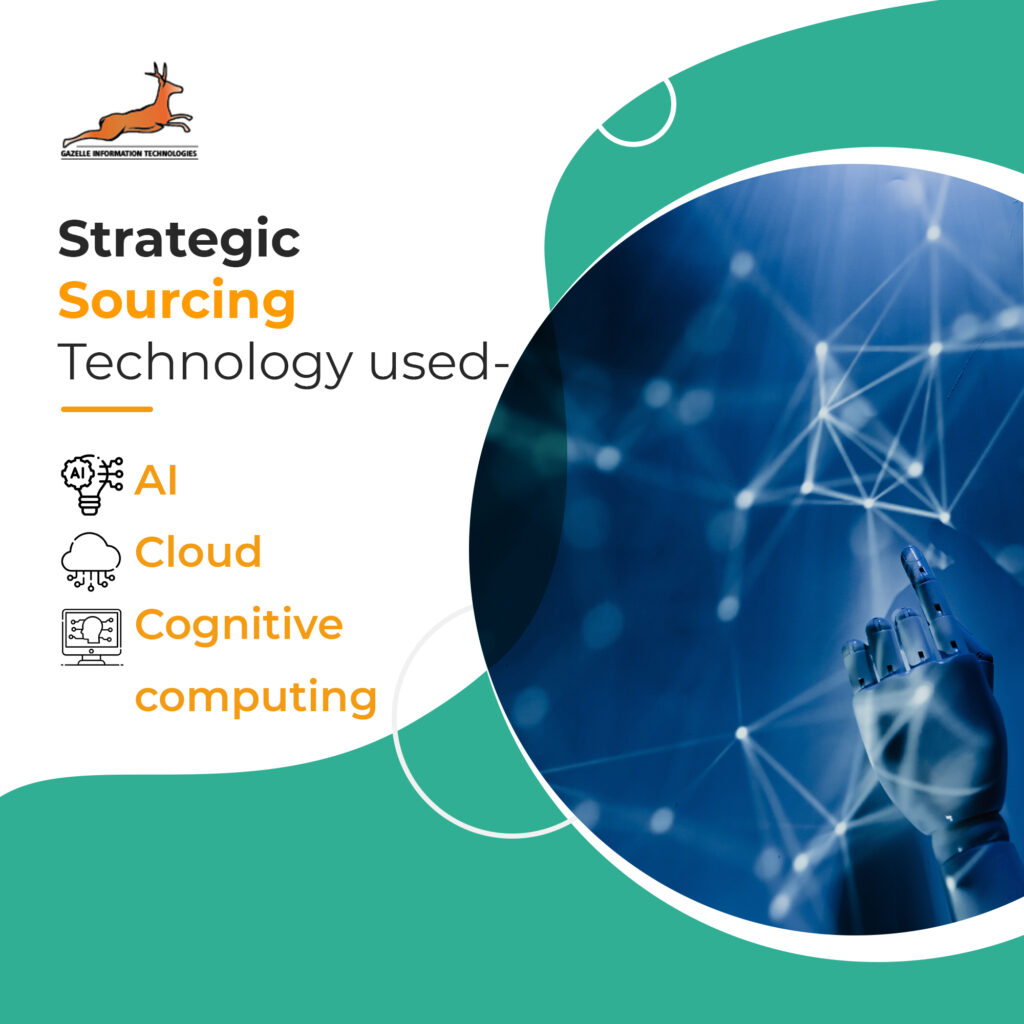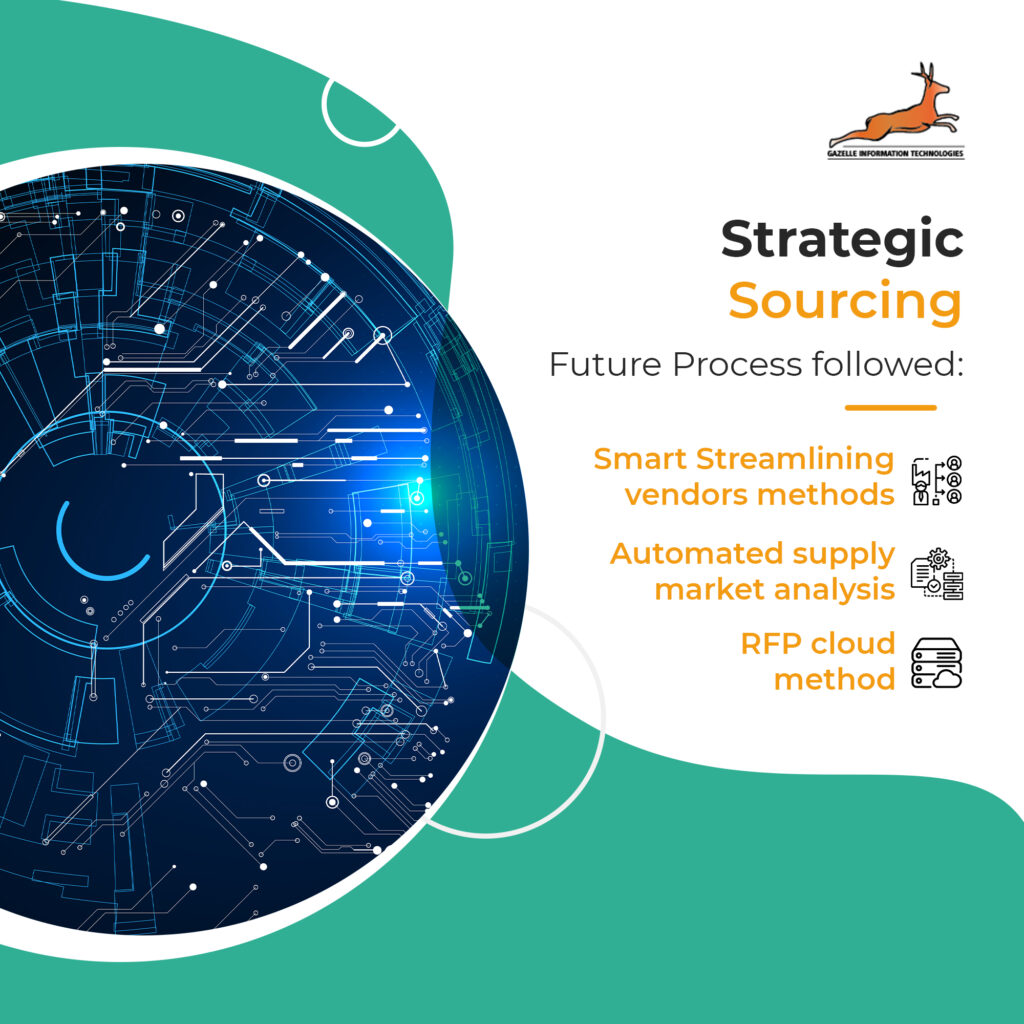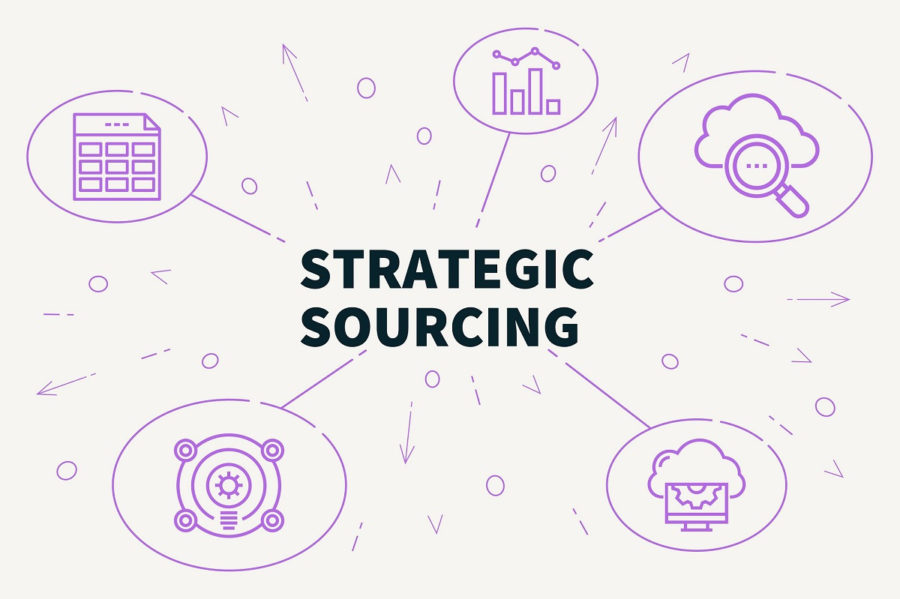Strategic Sourcing
Transformation Spectrum

- PAST
- PRESENT
- FUTURE
Technology Used:
- Direct material procurement
Process Followed:
- DEA model
- FDH model
 Technology Used:
Technology Used:
- AI
- Cloud
- Cognitive computing
Process Followed:
- RFP model
- RFI model
- RFQ model
 Technology to be used:
Technology to be used:
- Blockchain
- IoT
- Sensors and wearables
- Intelligent content extraction
Process to be followed:
- Smart Streamlining vendors methods
- Automated supply market analysis
- RFP cloud method

Technology Used
Past
Direct material procurement – Direct sourcing is the expenditure on raw materials, goods, and services to produce goods or services. It relies heavily on its supplier network and material availability and quality. Direct procurement connects multiple items purchased from various suppliers with varying delivery and production schedules.
Present
AI – Artificial intelligence (AI) allows Procurement organizations to solve complex problems more efficiently or effectively using smart computer algorithms. AI can be embedded into a number of software applications from spend analysis to contract management and strategic sourcing. AI solutions not only simplify these remedial tasks but can also decode complex systems and solve issues using computer software. Tasks like strategic sourcing can be embedded into an algorithm that does all the heavy lifting and provides all the actionable insights you require. Additionally, AI helps procurement professionals with data management as well as assists with gaining insight into large amounts of data at a faster rate. Something no human being can easily replicate.
Cloud – Cloud sourcing is the delivery of outsourced IT assets through a cloud-based, or internet, platform. cloud-based procurement automates the process from purchase to payment. It determines Business Needs which aligns your procurement strategy with your business goals. It chooses the right cloud service and finds a cloud solution that best meets organizational needs. You must have software features like customer support, budget management, three-way matching, etc. It ensures security. Enables flexibility also.
Cognitive computing – Cognitive Sourcing takes data “as it comes in and turns it into insight by ranking the information based on its impacts. is a method of using disruptive technologies to aid in the management of the procurement function. It is the process of using self-learning technology to process data in order to aid in the process of acquiring or buying goods and services.
Future
Blockchain – Blockchain Technology in procurement provides transparency at every stage of the supply chain lifecycle. This is because it can keep a record of every single transaction that has occurred. With this high level of transparency, all parties in the supply chain are aware of what’s going on at any given time. Blockchain provides all parties within a respective supply chain with access to the same information, potentially reducing communication or transfer data errors. Less time can be spent validating data and more can be spent on delivering goods and services.
IoT (Internet of Things) – The Internet of Things will bring greater spending visibility and a better understanding of supply and equipment utilization for procurement. data generated through IoT sensors and other devices can help make informed decisions. It helps in the surveillance of inventory for maintaining optimal stock levels, defining the corresponding total expected cost, providing important references for the suppliers, customer demand defining and forecasting, analyzing specific attributes for more informed decisions, eliminating the illiquidity risk, smart metering management, and advanced safety and security.
Sensors and wearables – The sensors also alert supply chain managers if a product has been altered or messed with, which more businesses will likely be interested in amidst reports of increasing cargo crime rates. Any notifications the organization gets can be delivered to employees’ digital devices. Sensors in the supply chain assist with location, the temperature of the vehicle, the pressure of the vehicle, and more. These inputs come in use when supply chain executives need to monitor the conditions of a package or vehicle and locate exactly where it is and where it is heading. They increase the level of automated collection and processing of data and broaden management visibility across the supply chain to help companies reduce operating costs, improve asset efficiency, and generate incremental revenue.
Processes to be followed
Past
DEA model – Data envelopment analysis (DEA) is a nonparametric method measuring relative carbon emissions reduction efficiency within a group of homogeneous decision-making units (DMUs) with multiple inputs and multiple outputs. This technique calculates efficiency and evaluates the system performance using a weighted ratio of outputs to inputs and the creation of an efficient frontier.
FDH model –
Present
RFP model – A request for proposal (RFP) is designed to help shippers find the best 3PL providers to meet their needs. The goal of an RFP is to ensure a prosperous partnership and good working relationship for both parties, and finding the right fit starts with a comprehensive and detailed RFP process. The RFP invites relevant vendors to submit a proposal to meet the desired need. More specifically, the RFP is a document that explains a project’s needs and asks for proposed solutions from potential vendors.
RFI model – An RFI (request for information) is a formal process for gathering information from potential suppliers of a good or service. The construction RFI is a formal written process in which parties, such as the contractor and designer, clarify information gaps in construction documents.
RFQ model – Request for quote (RFQ) is a process wherein an enterprise asks a set of potential suppliers or service providers to submit their price quotations and stand a chance to supply or provide goods or services. A company creates and issues an RFQ, and vendors offer price quotes. The business then chooses the lowest bid and signs a contract with the preferred vendor.
Future
Smart streamlining vendors methods – The art of improving the efficiency of a process, business, or organization by taking out or simplifying unnecessary steps. There are 5 steps to streamlining your supply chain. They are reviewing and optimizing supply chain processes, integrating supply chain data from A to Z, eliminating duplicate data, leveraging existing systems, and thinking ahead.
Automated supply market analysis – The use of digital technologies to improve efficiencies, connect applications and streamline processes within supply chain operations. All systems are connected to a centralized location that provides real-time data, status updates, and one single source of truth for the entire supply chain.
RFP cloud method – This is a document that explains a project’s needs and asks for proposed solutions from potential vendors.
Strategic Sourcing
- Strategic sourcing is a process that collects data collection, spend analysis, market research, and contracting.
- Strategic sourcing is an approach to supply chain management to find the best value in the marketplace and align its purchasing strategy to business goals.
The goal of strategic sourcing
- It helps an organization build long-term relationships with its supplier
- It aims to achieve the lowest total cost of ownership (TCO) along with minimal supply chain risk.
- It also helps to create a synergy between the organization and its supplier
Importance of Strategic Sourcing
- Strategic sourcing ensures they are always achieving high-cost savings and minimizing risk within the supply chain.
- It also brings opportunities to build long-term relationships with suppliers.
- The strong relationship makes it easier to identify risks, and forecast sales.
Future of Strategic Sourcing
- Procurement professionals are expected to deliver service beyond cost reduction.
- Collection and in-depth analysis of essential data to consider the best-in-class-go-forward strategy.
Future of Technology used for Strategic Sourcing in Supply Chain
- The new technology that will be used for strategic sourcing is going to be business networks, Artificial Intelligence, and Machine Learning.
- Automation is going to play an important role in the transformation from procurement to strategic sourcing.
- The function will operate with great speed, intelligence, and efficiency than ever.
Future of Process used for Strategic Sourcing
- It will help to identify the spend area key, as you need to divide the supply chain into various categories.
- Perform Supply market analysis will determine if new suppliers are worth the risk or not.
- Initiate a request for quotation (RFQ) this will help you to spend less time in the negotiation and keep the process transparent.

